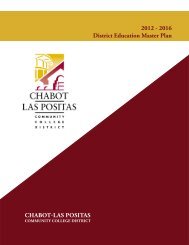City College of San Francisco - California Competes
City College of San Francisco - California Competes
City College of San Francisco - California Competes
Create successful ePaper yourself
Turn your PDF publications into a flip-book with our unique Google optimized e-Paper software.
STANDARD II.A<br />
Other institution-wide efforts promote the goal<br />
<strong>of</strong> meeting employment standards. One vital<br />
component is that occupational programs are<br />
required to meet with industry advisory boards.<br />
Many programs rely on their part-time faculty,<br />
who bring to the students their direct, relevant<br />
and current experience in the field, which results<br />
in an ongoing dialog with full-time faculty and<br />
the eventual revision <strong>of</strong> curriculum to reflect<br />
industry practices and standards. Additionally,<br />
many faculty are active members, or even board<br />
members <strong>of</strong> industry or pr<strong>of</strong>essional associations,<br />
such as the American Association for Paralegal<br />
Education, the Pr<strong>of</strong>essional Aviation<br />
Maintenance Association, the American Institute<br />
for Floral Designers and several pr<strong>of</strong>essional<br />
health associations. These relationships strengthen<br />
connections to industry and enhance the<br />
curriculum development process.<br />
The DACUM process (described in the response<br />
to Standard II.A.1.) is another means by which<br />
the <strong>College</strong> meets the needs <strong>of</strong> industry in the<br />
curriculum that it <strong>of</strong>fers.<br />
There is no institution-wide mechanism for<br />
measuring student job placement. However,<br />
the VTEA Core Indicator Report demonstrates<br />
how many graduates who have received a vocational<br />
degree or certificate are covered by the<br />
State Unemployment Insurance program.<br />
Unfortunately, this Core Indicator Report does<br />
not reflect how well the institution’s graduates<br />
meet employment standards nor does it measure<br />
those “student completers” who find employment<br />
out-<strong>of</strong>-state, become self-employed, or<br />
join the military.<br />
Many vocational programs include a work-based<br />
learning component through internships, work<br />
experience or clinical experience. Often students<br />
find employment as a result <strong>of</strong> their work-based<br />
learning experience, but no formal tracking system<br />
measures the frequency <strong>of</strong> this occurrence.<br />
II.A.6. The institution assures that students and<br />
prospective students receive clear and accurate<br />
information about educational courses and<br />
programs and transfer policies. The institution<br />
describes its degrees and certificates in terms <strong>of</strong><br />
their purpose, content, course requirements, and<br />
expected student learning outcomes. In every<br />
class section students receive a course syllabus<br />
that specifies learning objectives consistent with<br />
those in the institution’s <strong>of</strong>ficial approved course<br />
outline.<br />
II.A.6.a. The institution makes available to<br />
its students clearly stated transfer-<strong>of</strong>-credit<br />
policies in order to facilitate the mobility<br />
<strong>of</strong> students without penalty. In accepting<br />
transfer credits to fulfill degree requirements,<br />
the institution certifies that the expected<br />
learning outcomes for transferred courses are<br />
comparable to the learning outcomes <strong>of</strong> its<br />
own courses. Where patterns <strong>of</strong> student<br />
enrollment between institutions are identified,<br />
the institution develops articulation<br />
agreements as appropriate to its mission.<br />
II.A.6.b. When programs are eliminated<br />
or program requirements are significantly<br />
changed, the institution makes appropriate<br />
arrangements so that enrolled students may<br />
complete their education in a timely manner<br />
with a minimum <strong>of</strong> disruption.<br />
II.A.6.c. The institution represents itself clearly,<br />
accurately, and consistently to prospective<br />
and current students, the public, and its personnel<br />
through its catalogs, statements, and<br />
publications, including those presented in<br />
electronic formats. It regularly reviews institutional<br />
policies, procedures, and publications<br />
to assure integrity in all representations about<br />
its mission, programs, and services.<br />
126 CITY COLLEGE OF SAN FRANCISCO







